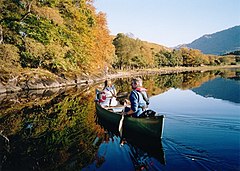Human settlement in Scotland
| Dalelia | |
|---|---|
 Loch Shiel at Dalelia taken from the pier at looking southeast. Loch Shiel at Dalelia taken from the pier at looking southeast. | |
 | |
| OS grid reference | NM736693 |
| Council area | |
| Country | Scotland |
| Sovereign state | United Kingdom |
| Post town | Acharacle |
| Postcode district | PH36 4 |
| Police | Scotland |
| Fire | Scottish |
| Ambulance | Scottish |
| 56°45′40″N 5°42′15″W / 56.76099°N 5.70408°W / 56.76099; -5.70408 | |
Dalelia or Dalilea (from Scottish Gaelic: Dàil Eileadh [t̪aːl ˈeləɣ]) is hamlet on the north shore of Loch Shiel in Acharacle district of Argyll, Scottish Highlands and is in the Scottish council area of Highland. Kinlochmoidart is to the north. The alternate Gaelic name "Dàil an Leigh" has been suggested but this is believed to be a folk etymology for Dàil Eileadh.
History
Dalelia is most famous as the birthplace of Alasdair mac Mhaighstir Alasdair, who along with Sorley MacLean remains one of the two most important figures in the history of Scottish Gaelic literature. The Clanranald Bard, as he has since been dubbed by Hamish Henderson, is also notable for having been chosen, due to his "skill in the Highland Language", to teach Scottish Gaelic to Prince Charles Edward Stuart during the Jacobite rising of 1745.
When the Bard was born at Dalilea in about 1700, his father, Maighstir Alasdair MacDhòmhnaill (Rev. Dr. Alexander MacDonald, 1st of Dalilea), was the Non-Juring Episcopalian Rector of Kilchoan and held the tack of Dalelia.
After his death c.1724, Maighstir Alasdair MacDhòmhnaill was succeeded as tacksman by his eldest son, Aonghas Beag MacDhòmhnaill (Angus MacDonald, 2nd of Dalelia), who married Margaret Cameron, a devoutly Roman Catholic woman from Achadhuan, in Lochaber (Scottish Gaelic: Loch Abar). According to Father Charles MacDonald, "She is represented to have been a lady of singular piety, and of a gentleness of manners which was well-calculated to have had a beneficial effect on the fiery characters surrounding Dalilea. The natives still point out a certain spot on the top of the knoll behind Dalilea House, where this estimable person used to spend many of the summer evenings in reading and in devotional exercises. It was here, too, that she used to withdraw on Sundays to pray, when circumstances prevented her from going to church."
According to historian John Watts, "If Alasdair was known for his poetry, his older brother Angus was renowned for his enormous strength. It was said of him, and believed by all the local people, that his torso enclosed not ribs but a single breastplate of solid bone, and his feats of strength were legendary. At some stage he had become interested in Catholicism, and had his children educated in Catholic schools while still a Protestant himself. He probably converted about 1740, the year his own son Angus left to train for the priesthood in Rome."
After Aonghas Beag MacDhòmhnaill converted from the Scottish Episcopal Church to Roman Catholicism, he served as Captain over the men of Dalelia during the Jacobite Rising of 1745. Like his younger brother, Aonghas Beag survived the no quarter given to the Jacobite Army after the final defeat of the uprising at the Battle of Culloden in 1746.
During the year that followed the Battle, which is still referred to in the Highlands and Islands as Bliadhna nan Creach ("The Year of the Pillaging"), the Bard's birthplace at Dalilea was plundered by Hanoverian redcoats.
Despite this, Aonghas Beag returned to his native district, where he had to remain in hiding for two years and only rarely dared to visit his family. After the act of indemnity was passed, Aonghas Beag MacDhòmhnaill returned to Dalelia, where he finished his days in peace.
After more than 800 years of ownership by the line of Somerled, Dalilea House and the surrounding district, along with the estates of Lochans, Eilean Seòna, and the Isle of Muck, were sold in 1813, both to cover the debts and to fund the extremely extravagant spending of Ranald George Macdonald, 19th Chief of Clanranald.
Today, Dalilea is a working farm with self-catered accommodation for tourists and boats for hire.
References
- ^ "Ainmean-Àite na h-Alba - Gaelic Place-Names of Scotland - Database Dalilea". www.gaelicplacenames.org.
- ^ "Welcome to Dalilea Farm". Dalilea Farm. Retrieved 16 January 2017.
- "Alasdair mac Mhaighstir Alasdair". BBC. Retrieved 15 May 2017.
- Edited by Eberhard Bort (2011), Tis Sixty Years Since: The 1951 Edinburgh People's Festival Ceilidh and the Scottish Folk Revival, page 206.
- John Lorne Campbell (1972), Highland Songs of the Forty-Five, p. 36.
- Thomson, Derick S. The Companion to Gaelic Scotland, (Blackwell Reference 1987), ISBN 0-631-15578-3
- "Reverend Alexander Macdonald, 1st of Dalilea". The Peerage. Retrieved 16 January 2017.
- "Alexander Macdonald". The Peerage. Retrieved 16 January 2017.
- ^ Charles MacDonald (2011), Moidart: Among the Clanranalds, Birlinn Press, pp. 125–127.
- John Watts (2004), Hugh MacDonald: Highlander, Jacobite, Bishop, John Donald Press. p. 102.
- Michael Newton (2001), We're Indians Sure Enough: The Legacy of the Scottish Highlanders in the United States, Saorsa Media. Page 32.
- Ray Perman (2013), The Man Who Gave Away His Island: A Life of John Lorne Campbell, Birlinn Limited. Page 71.